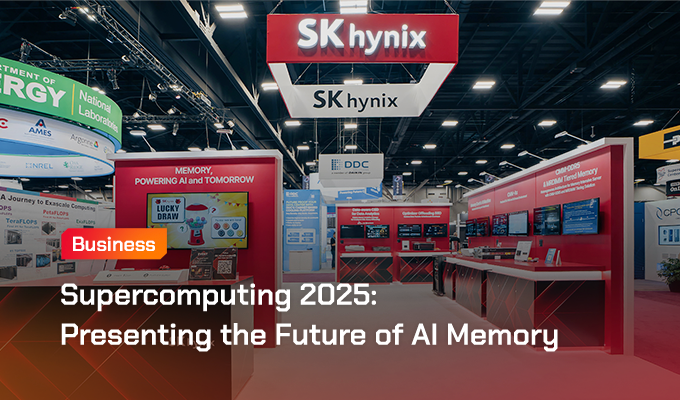In March 2024, SK hynix began mass production of the world’s best-performing HBM3E1. Coupled with the company’s announcement that it is bringing forward the planned mass-production of its next-generation HBM4 to 2025, SK hynix is cementing its position as the “Global No.1 AI Memory Provider”.
1HBM3E: The fifth-generation and latest High Bandwidth Memory (HBM) product. HBM is a high-value, high-performance product that revolutionizes data processing speeds by connecting multiple DRAM chips with through-silicon via (TSV). The five generations of HBM began with the original HBM, followed by HBM2, HBM2E, HBM3, and HBM3E.
In the past two to three years, HBM has gained widespread recognition following the rise of generative AI. While this may have led to the perception that SK hynix’s HBM achievements were almost an overnight success, the company has undergone a long journey to reach its leadership position. SK hynix’s ascent to the top of the HBM industry has been driven by the unique technical expertise of its top engineers, who have dedicated more than 15 years to the research and development of HBM technology.
To find out more, the newsroom met with Vice President Myeong-jae Park, head of HBM design, to discuss the history and success story of SK hynix’s HBM technology.
From HBM’s Origins to Industry Leadership: Relentless Refinement and Perseverance

SK hynix’s HBM development history
In 2009, SK hynix foresaw an increasing demand for high-performance memory and turned its attention to TSV2 technology. Four years later in December 2013, the company released the world’s first HBM based on TSV.
2Through-Silicon Via (TSV): A technology that involves drilling microscopic holes in a DRAM chip to connect the electrodes that vertically penetrate the holes of the upper and lower layers of the chip.
Despite the breakthrough, it took many years for SK hynix to be acknowledged for its HBM. In the 2010s, the computing market was not mature enough to benefit from the specifications of HBM, which was perceived as offering “unnecessarily” high speed and large capacity. This led to difficulties during the development of the second-generation HBM, HBM2, and prompted concerns about the business value of the product. Park refers to this challenging time as a period for discovering opportunities.

Park pinpointed HBM2E as a key turning point in the company’s HBM business
“In the mid-to-late 2010s, the HBM design department was openly described as somewhere off the beaten path,” he recalled. “The company was experiencing difficulties in the process of developing HBM2, and above all, the market growth was slower than expected. This situation fueled concerns about the business and pessimism throughout the industry.
“Nevertheless, we firmly believed that HBM was an opportunity to showcase SK hynix’s unique technological capabilities, and that once we developed the best products, services to utilize them would naturally emerge in the market. This conviction became the driving force behind the development of subsequent products, including HBM2E.”
Through this process, Park learned that the key to success is to achieve a first-class performance level that far surpasses the demands of customers and the market. He recalled embarking on the development of HBM2E with this steadfast determination.
“From HBM2E onwards, we set our goals far higher than external expectations and strengthened collaboration,” he revealed. “For HBM, which requires the seamless integration of complex and challenging technologies, it was particularly important to collaborate with relevant teams to solve difficult problems and enhance synergy. This approach led to significant technological advancements.
“During this period, we laid the groundwork for fundamental technologies such as MR-MUF3, HKMG4, and Low-K IMD5, as well as the design and testing technologies that form the foundation of our current capabilities.”
3Mass Reflow Molded Underfill (MR-MUF): A process involving injecting a liquid protective material between stacked chips, which is then hardened. Compared to the traditional method of placing film-like materials between each layer, MR-MUF is a more efficient process and more effective at heat dissipation. SK hynix’s advanced MR-MUF reduces the pressure applied during chip stacking and improves chip warpage control compared to the traditional process, supporting the stable mass production of HBM.
4High-K Metal Gate (HKMG): A next-generation process that uses a material with a high dielectric constant (K) in the insulating layer inside DRAM transistors. This prevents leakage current caused by process miniaturization and improves capacitance, the amount of charge required for data storage, enabling faster processing while reducing power consumption.
5Low-K Inter Metal Dielectrics (Low-K IMD): A technology that inserts materials with a low dielectric constant (K) between the internal wiring of semiconductor chip to reduce electrical interference and enhance performance.
Pioneering the HBM Renaissance With Proprietary Technology
In the early 2020s, fierce competition was predicted among memory companies for dominance of the HBM3 market. However, SK hynix defied expectations for such a battle as it soon solidified its industry leadership position through relentless technology development and investment.

Park claimed performance, quality, and market responsiveness gave SK hynix an edge for HBM
“At the time, SK hynix was not only innovating in terms of technology,” he said. “We were also continuously innovating to enhance customer relationships and quality. Eventually, we secured a significant market share with our HBM3 due to its overwhelmingly superior performance and features, and firmly established our position as the HBM market leader.”
Since then, SK hynix’s HBM success story has forged ahead unimpeded. Only four months after developing the world’s highest capacity 12-layer HBM3, the company introduced the next-generation HBM3E in August 2023, dramatically reducing the time to market.
“As competition among AI companies intensified, we had no choice but to accelerate our development of HBM,” he said. “To this end, SK hynix made efforts such as enhancing the completeness of product design and collaborating with customers from the early stages of development and mass production. As a result, we were able to start the mass production of HBM3E in March 2024, becoming the first company in the world to do so.”
Park emphasized that the secret to such success can be defined by performance, quality, and market responsiveness.
“SK hynix’s HBM boasts the industry’s highest speed and performance,” he said. “In particular, our proprietary MR-MUF technology, which was applied to our HBM products, contributed to achieving the world’s best performance by stably reducing the heat generated by high–performance processes. In addition, we were quickly able to consistently mass-produce these products to a high standard. We also offered an unrivaled level of customer responsiveness. I believe this comprehensive competitive edge has elevated our HBM3E to its status as a premier product.”
Park also underlined the key role all of SK hynix’s members played in HBM’s success, as they were dedicated to achieving continuous technological innovation as one team without ever becoming complacent.

Park cited cross-company collaboration as key to developing HBM3E
“Since HBM2E, SK hynix has consistently strived to maintain its number one position in the HBM field,” he stated. “In particular, we aimed to increase performance by 50% for each new generation while maintaining the same level of power consumption. This seemed almost impossible, but we were able to achieve it with the support of many of our departments and organizations, including Packaging and R&D.
“Additionally, when challenges arose during the development and mass production stage, the organizations with expertise in the relevant fields provided solutions. I believe that such a collaborative system made it possible to produce the world’s best-performing HBM3E.”

Park (second from the left) with the rest of the winners of SK Group’s 2024 SUPEX Award presented by SK hynix CEO Kwak Noh-Jung
(far left) and SUPEX Council Vice Chairman Chey Chang-won (far right) (Photo credit: SK Group)
Along with key technical personnel from SK hynix, Park was awarded the 2024 SUPEX Award6, the highest honor of SK Group, on June 5 for his contributions to the development of HBM.
6SUPEX Award: As the most prestigious award within SK Group that carries the meaning “super excellent,” it recognizes members who have successfully realized innovations by not being afraid to take on new challenges.
“I am deeply humbled and grateful to receive the SUPEX Award on behalf of the many members who have contributed to HBM product development,” he said. “HBM not only demonstrates SK hynix’s technological prowess but also leads the advancement of AI technology, making a significant contribution to society as a whole. Going forward, we will do our best to ensure that the company can continue to play this role.”
Next-Generation HBM: Maintaining Industry Leadership Through Innovation & Customization
Commenting on recent speculation regarding the development of HBM, Park dismissed the claims as “groundless” and reaffirmed his determination to maintain SK hynix’s competitive edge in the future. He said: “SK hynix’s HBM is the fruit of 15 years of hard work by our employees. Recently, there was an unfounded rumor that a competitor’s HBM team had transferred to SK hynix to develop the technology. This impacted the pride of our members as it disregarded the achievements made through our own efforts. SK hynix’s HBM is clearly developed using its own technology, and there was not a single person who joined the company’s HBM design organization from a competitor at that time. We now see this as a testament to our outstanding technological capabilities, which have gained such recognition that they have sparked these false rumors. We will not be affected by these claims and will continuously work hard to maintain our leadership.
“Continuous innovation is essential to maintaining and enhancing our current status,” he added. “Especially as our HBM lineup diversifies with the customization of solutions, collaboration with customers and the foundry industry will become increasingly important in the future. Amid these changes, we aim to steadily move forward, keeping pace with trends to maintain market leadership.”

Park claims SK hynix’s various AI memory technologies will create new opportunities
Wrapping up the interview, Park expressed his confidence in next-generation AI technology beyond HBM and shared his future aspirations.
“Not only HBM but also various AI memory technologies such as CXL®7, PIM8, and 3D DRAM will create new opportunities, and the company is ready to maintain its leading position in these next-generation AI memory fields,” he stated.
“In retrospect, HBM was the starting point for us to expand the company’s business into high-value-added areas. I feel both pride and a sense of responsibility. The HBM design team will continue to innovate, believing in the technology and collaborative systems we have built with our members over the years, without resting on our laurels. We will work hard to grow SK hynix into a key company leading the entire AI industry.”
7Compute Express Link (CXL)®: A technology that integrates the interface between memory and other devices into one to more easily expand bandwidth (data transmission path) and capacity to implement high-performance computing systems.
8Processing-In-Memory (PIM): Next-generation intelligent semiconductor memory that incorporates the computing functions of a processor.







